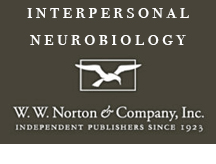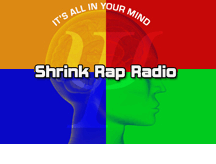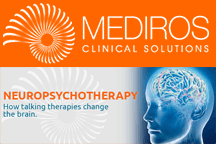THE NEUROPSYCHOTHERAPIST
Issue #14 (May 2015)
ISSN 2201-9529
CONTENTS
This month we are immersing ourselves in music! As someone who has studied at a conservatorium of music, been involved in bands, written music for orchestra, scored for film, and produced albums, it is a subject very close to my heart. Music has unique qualities that can resonate with our current emotional states—either to lift us up or inspire us, or simply to walk with us in the darker times, like a faithful friend who just seems to “get” us. Courtney Armstrong explores the power of music in Music: A Powerful Ally in the Therapy Room where she shares with us some simple and effective ways of using music in the therapeutic setting.
She shows how music can be used to strengthen the connection between therapist and client, help in the process of grief, reduce anxiety, help relationships, and assist in the resolution of trauma. Also in this issue we have pain and trauma expert Mark Grant giving us an up-to-date understanding of pain from a neuropsychological perspective and showing how we can use the latest neuroscience to inform our approach to chronic pain. In his practice, Mark uses EMDR as the main intervention for chronic pain sufferers and here he gives a theoretical explanation of what is actually happening on a neural level when we use bilateral stimulation, the method’s defining feature. It is certainly true that a clinician can perform an intervention like EMDR without specialist knowledge. Nevertheless, to have a coherent rationale about what you are doing and why, and to be able to explain it to your clients in a sophisticated way, not only gives them more confidence in what you are doing but can also give you clinical insight that goes way beyond just doing the technique. Integrating this neuroscience knowledge with curiosity, intuition, and proven techniques will advance your clinical competence in a most satisfying way.
I do hope you enjoy this issue.
-Ed.
The Neuropsychotherapist Members Only content
MEMBERS: Be sure you are logged in to see your viewing options Members Login Not a member? Click on Subscription to find out more.
Features
Music: A Powerful Ally in the Therapy Room
Music can have a profound impact on our affect and the activity of our brains. Courtney explores the use of music in therapy from her own clinical experience in the areas of grief, depression, relationships and trauma.
Courtney Armstrong
Neuropsychology of Chronic Pain & Eye Movement Desensitization & Reprocessing
Mark gives us an understanding of pain in the brain and the therapeutic implications of what we know so far. Mark’s intervention of choice is EMDR and he explains what the science is telling us about the mechanisms of change in the brain when using EMDR therapy to deal with chronic pain.
Mark Grant
Regulars
- From the Editor: Matthew Dahlitz
- Mechanisms of Change: Karen Young
- Applied NTP: Matthew Dahlitz
41 pages
Not A Subscriber?
You can purchase individual downloadable PDF issues here
- Your cart is empty.
![]() Alternatively you can subscribe to our magazine on the iTunes Newsstand with a month-to-month subscription plan. Please note that the Newsstand subscription is completely separate to subscribing to our website - you will not have member access to this website with only an iTunes subscription. However, you may appreciate the automation and convenience of an iTunes subscription to have the magazine delivered to your iPad, rather than having to manually transfer it to your iPad reader as you would with a membership subscription to this website.
Alternatively you can subscribe to our magazine on the iTunes Newsstand with a month-to-month subscription plan. Please note that the Newsstand subscription is completely separate to subscribing to our website - you will not have member access to this website with only an iTunes subscription. However, you may appreciate the automation and convenience of an iTunes subscription to have the magazine delivered to your iPad, rather than having to manually transfer it to your iPad reader as you would with a membership subscription to this website.
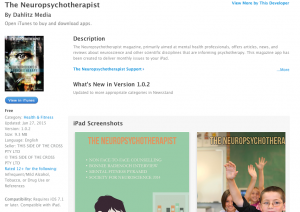
An Issue of the Heart
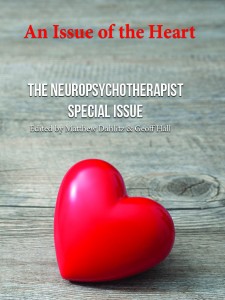 Hard copy book now available from Amazon.com:
Hard copy book now available from Amazon.com:
The Neuropsychotherapist Special Issues are anthologies of articles that have been published in the monthly magazine The Neuropsychotherapist.
This special issue is all about the heart… A wonder of complexity is the human being—something that continues to be a source of fascination and frustration for those of us who have set ourselves to understand human behaviour. This special issue focuses on the heart, an organ with a profound influence over our mental lives.
We are all familiar with the heart in its classical biological role as pump circulating vital oxygenated blood through the body. But how many are versed in its neural and bioelectromagnetic influence upon our brains? Research has revealed the heart even radiates an influence on those around us via electromgnetic fields. In the past such claims might have been dismissed as mere New Age fancy, but with ever more sophisticated and sensitive instruments, formal studies in recent years have demonstrated that our bodies have amazing multidimensional fields of awareness and influence. These findings about the heart continue to add weight to the argument that in the counselling room it is the therapist’s unconditional positive regard, warmth, and personal coherence more than any technique that make for effective therapy. It makes one wonder what the focus of training should be for new therapists—will courses become more focused on students developing personal coherence, practising attitudes of genuine care and compassion, and understanding what they are radiating to clients from their hearts?
Neuropsychotherapy, and the multidisciplinary integration that it stands for, is part of an important paradigm shift in medicine. Likewise, the focus on matters heart–brain in this issue reflects an important shift of understanding in the broader field of health. The study of any one bodily system—even the central nervous system in the case of psychologists—leaves us in the dark on many levels for many phenomena. It is our hope that you will come to appreciate the wonderful, so often implicit influence the heart has on our emotions and relationships, and that we will become more conscious of being authentic and coherent—for our clients and also for ourselves.

